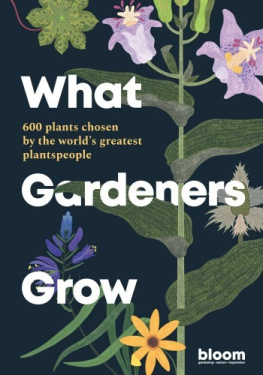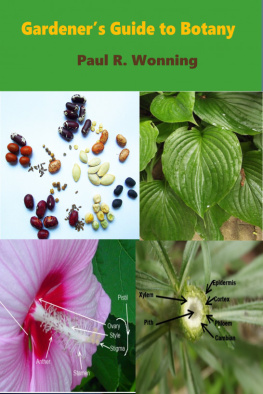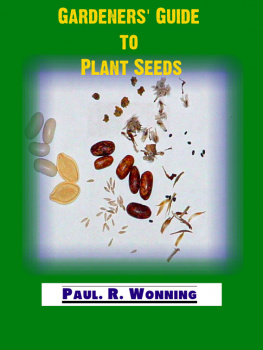Nellie Neal - Gardeners Guide to Tropical Plants
Here you can read online Nellie Neal - Gardeners Guide to Tropical Plants full text of the book (entire story) in english for free. Download pdf and epub, get meaning, cover and reviews about this ebook. year: 2012, publisher: Cool Springs Press, genre: Home and family. Description of the work, (preface) as well as reviews are available. Best literature library LitArk.com created for fans of good reading and offers a wide selection of genres:
Romance novel
Science fiction
Adventure
Detective
Science
History
Home and family
Prose
Art
Politics
Computer
Non-fiction
Religion
Business
Children
Humor
Choose a favorite category and find really read worthwhile books. Enjoy immersion in the world of imagination, feel the emotions of the characters or learn something new for yourself, make an fascinating discovery.

- Book:Gardeners Guide to Tropical Plants
- Author:
- Publisher:Cool Springs Press
- Genre:
- Year:2012
- Rating:4 / 5
- Favourites:Add to favourites
- Your mark:
- 80
- 1
- 2
- 3
- 4
- 5
Gardeners Guide to Tropical Plants: summary, description and annotation
We offer to read an annotation, description, summary or preface (depends on what the author of the book "Gardeners Guide to Tropical Plants" wrote himself). If you haven't found the necessary information about the book — write in the comments, we will try to find it.
Gardeners Guide to Tropical Plants — read online for free the complete book (whole text) full work
Below is the text of the book, divided by pages. System saving the place of the last page read, allows you to conveniently read the book "Gardeners Guide to Tropical Plants" online for free, without having to search again every time where you left off. Put a bookmark, and you can go to the page where you finished reading at any time.
Font size:
Interval:
Bookmark:
Gardeners Guide to
Cool Ways to Add Hot Colors,
Bold Foliage, and Striking Textures

My passion for tropical plants comes from deep in my soul, but most of my knowledge of how to grow them comes from time spent in the greenhouses at LSU with Dr. Ed ORourke and Dr. Carlos Smith. No one ever had better mentors and friends. My curiosity and the beauty of these plants led me to study more tropicals, and hundreds of questions from gardeners steer me to the rest, day by day. There is a horde of people who helped with this book by enthusiastically offering ideas and feedback. You know I owe you, and I know you will collect.
My heartfelt thanks to the unsinkable Billie Brownell, Editor Extraordinaire, for her calm hand on the tiller. She and her team at Cool Springs Press turn words into books and that is the greatest gift a writer can get. Thanks to Horticulture Editor Steve Asbell for wise counsel and taxonomic wizardry, and to Glenn Stokes, who has wooed many to grow tropical plants with his catalogs, website, and remarkable photography. This book was originally the brainchild of Cindy Games and the late Roger Waynick, to whom I owe a debt of thanks for its genesis.
Featured Tropicals

When travelers dream of the tropics, there are palm trees, sandy beaches, and rum drinks for everyone. Gardeners, though, see much more than that. We see a technicolor display of colorful flowers, crazily painted leaves, and huge shapes that can dominate any landscape. We see the complexity of the blooms, long tubes with big disks, and bracts that have bodacious ways to attract the proper pollinators. Their colors span the spectrum and share a depth of hueeven in light shadesthat is rare outside frost-free zones. The lines they create are a wild ride for the eyes. They soar, curve, twist, and excite passions with scents that make us look their way. The patterned leaves on tropical plants can be neatly striped like a barber pole or seemingly random patches of color thrown together with no apparent reason. Tropical plants may be tall or short, but they are never wimpy; they present strong outlines and textures that cannot be ignored.

When gardeners see the variety, diversity, and drama offered by tropical plants, it is natural to want to grow them. If we live in tropical zones, each discovery is like a new favorite ice-cream flavor. We collect both those that thrive where we live and those from other tropical microclimates that require different conditions. Gardeners in the subtropic zones have great latitude in the tropical plants they can grow. Some of these plants are semihardy and may become perennial plants where frosts are few and far between; others can be grown as summer annuals and container specimens alone or in mixed pots. The subtropics offer numerous ways to keep tender plants alive indoors and over the winter. For too long, temperate-zone gardeners could find only a limited number of tropical plants at their favorite garden centers, but that has changed drastically. The overall availability of exotic plants has expanded by leaps and bounds in recent years as both local and mail order sources have taken advantage of the growing market. Whether grown as summer bedding plants or for long life in a container, tropicals can easily find a place in temperate zone gardens.

A tropical landscape is a technicolor display of colorful flowers, painted leaves, and bold shapes.
This book is designed to enable gardeners everywhere to better enjoy tropical plants. It will immerse you in their seductive charms and reveal their origins. These plants carry a mysterious aura with them wherever they go, but growing them will be quite straightforward with the help of this book. If you like tropical plants but are not sure why, their appeal is explained in terms of emotional allure and landscape impact, since both contribute to the totality of tropical beauty. You will learn about the features of particular plants so you can make smart choices, and youll find out how to care for these plants during each season. The discussion includes tropical plant growing both inside and outdoors, with simple propagation suggestions and details of likely challenges, including common pests. The tropical plants profiled here represent more than 130 plants that can be grown in and out of frost-free zones in garden beds and containers. Taken as a group, they represent a gardeners musical riffs on the theme of tropical tone. The individual profiles offer suggestions about where and how to grow that plant, which ones to plant in combination to create companionable vignettes, and notes other related plants that would be worth a look. Elsewhere, the book puts design tools at your fingertips to help you incorporate tropicals into your garden or start an oasis from scratch. Plant lists for various conditions and qualities are provided at the end of the book, along with a section of resources you will find valuable in building your tropical collection.
The tropics is a place, but it is also a state of mind. It is an obi, a wide sash around the waist of this big blue marble we call Earth. The belt spreads to 23 degrees 27 minutes north and south of the equator, a wide swath as diverse as the scores of cultures that arose there. Perhaps more than any other area of the world, the food, music, and plants of the tropics are embraced everywhere, even by people who have not yet visited the area. We grow tropical plants for the way they make us feel as surely as we feel the rhythm of son Cubano music in our hips without ever having visited Havana. Our instinctive reactions begin with feelings of warmthliterally, as the sun beats down and every cuisine includes peppers and spice. But our responses are also emotional and heartfelt, sometimes unexpectedly so. The tropics draw us to bask, to slow our pace and radiate good will as we ponder waves and undulating vines dripping with blooms. Those who live in the frost-free zones inhabit a different world, one where the sun beams directly down on our lives as if in affirmation of our good fortune. Everywhere else, the suns rays come in at an angle, with less intensity year-round. Here is the crucible of weather, where the trade winds crash together. The trade winds blow from the southeast to the northwest below the equator, and from the northeast to southwest above it. Over the equatoronly in the tropicsthe collision of these winds cook up weather patterns that travel the world. These forces are emblematic of the magnetism and power of the tropical belt, as are the tropical rainforests, Natures most efficient air-cleaning machines.
Put it all together and you get a blazing, bright, humid, languid, truly exotic place where perfumed fragrances waft day and night. The plants are flamboyant and gregarious, secretive and exotic by turns, each evolving in response to these climatic limitations with wildly different growth habits. Those plants that share certain traits are said to be related and are grouped into families to reflect those similarities. These taxonomic designations can be useful because knowing a plants family ties helps to organize them in your head. For example, most Euphorbiaceae family members ooze a latex sap when cut. Many of us have seen this sap when a branch breaks off a Christmas poinsettia. Put those two facts together and look it uppoinsettia is a member of the Euphorbiaceae family as well. This insight leads to others, as when you are instructed to let succulent and oozy stems restheal over or form callusbefore rooting them. Some of the plants that need this treatment must be on the Euphorbiaceae family tree, too, and poinsettia cuttings must need to heal over. They are, and they do. This is an example of how knowing the taxonomy of your plants can help you to care for them properly.
Next pageFont size:
Interval:
Bookmark:
Similar books «Gardeners Guide to Tropical Plants»
Look at similar books to Gardeners Guide to Tropical Plants. We have selected literature similar in name and meaning in the hope of providing readers with more options to find new, interesting, not yet read works.
Discussion, reviews of the book Gardeners Guide to Tropical Plants and just readers' own opinions. Leave your comments, write what you think about the work, its meaning or the main characters. Specify what exactly you liked and what you didn't like, and why you think so.






